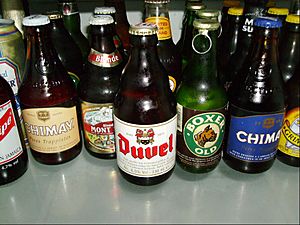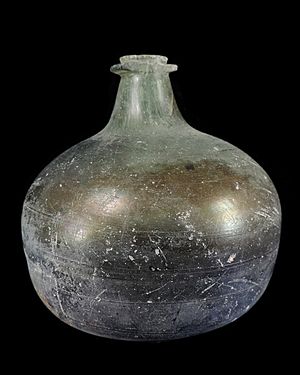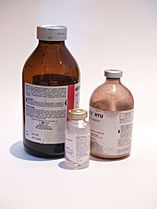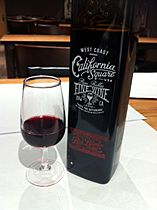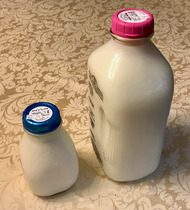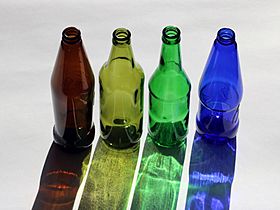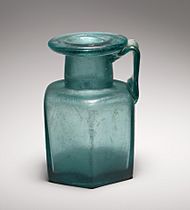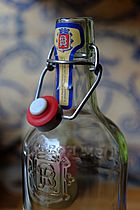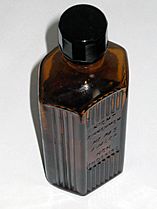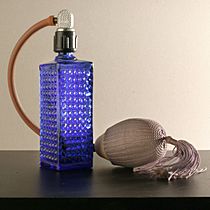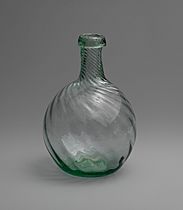Glass bottle facts for kids
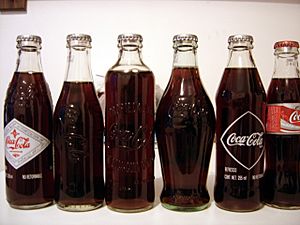
A glass bottle is a container made from glass. Glass bottles come in many sizes. They usually hold between 200 milliliters and 1.5 litres. People use glass bottles for many things. They hold food items, drinks like soda and juice, and even cosmetics. Sometimes, people even put messages inside them to send across the water! These bottles are very useful in many businesses.
Contents
How Glass Bottles Were Made Long Ago
Glass bottles are found in homes all over the world. The first glass bottles were made a very long time ago. This was around 1500 B.C. in a place called Mesopotamia. Later, the Roman Empire also started making them around 1 A.D.
In the early 1600s, settlers in Jamestown, America, built the first glass-making furnace. This was the start of the glass bottle industry in America. A big change happened in 1903. An invention called the automatic glass bottle-blowing machine made it much easier to make bottles. This machine helped make bottles faster and cheaper.
How Glass Bottles Are Made Today
The very first glass containers were made in a simple way. People melted ingredients to make glass. Then, they dipped clay shapes into the hot liquid glass. Once the glass cooled, they chipped away the clay inside. This left a hollow glass container. These early glass items were very thin. This was because the fires back then were not as hot as modern furnaces.
Around 1 B.C., the blowpipe was invented. This was a big step forward! Glassmakers could gather hot, melted glass on the end of a long pipe. Then, they would blow into the other end. This made the glass puff out into a hollow shape.
Later, people started using molds. Molds are like cookie cutters for glass. They help shape the bottle perfectly. In 1886, a machine called the Press and Blow was invented. This made making bottles even faster. Then, in 1904, Michael Joseph Owens created the automatic bottle machine. This machine changed how bottles were made forever. It made the process very quick and efficient.
After bottles are made, they need to cool down slowly. This process is called annealing. It happens in a special oven called a 'lehr'. Cooling bottles slowly makes them much stronger. If they cool too fast, they can become weak and break easily.
Cool Features of Glass Bottles
Special Marks on Bottles
Modern glass bottles often have special marks on their bottom. These marks are like secret codes! They help factories know which machine made the bottle. This is important for checking quality. The marks can also show who made the bottle. They might even tell you how much liquid to fill the bottle with. Sometimes, they show the date the bottle was made.
Some bottles have raised letters or designs on them. This is called embossing. These raised parts were meant to tell the buyer something. They might say what was inside the bottle. Or they could show who owned the bottle.
How Bottles Are Sealed
Glass bottles need a way to close them. This keeps the contents safe inside. Very old bottles were often sealed with wax. Later, people started using corks to stop up the bottles. Today, you will most often see screw caps. These are easy to open and close. Sometimes, bottles also use stoppers, especially for fancy drinks.
What Happens to Old Glass Bottles
Glass recycling is a great way to reuse materials. When you recycle glass, a lot of the original material can be used again. Some countries have laws to encourage recycling. These laws might give you a small amount of money back when you return empty bottles. This helps make sure more glass gets recycled instead of thrown away.
Different Kinds of Glass Bottles
Here are some common shapes of glass bottles you might see:
- Boston round or Winchester bottles: These are cylinder-shaped. They have very rounded tops and bottoms. They often have thick glass and come in clear, blue, or amber colors. You often see them used for medicines or in science labs.
- Long-necked or Woozy bottles: These are tall and thin. They have a long, noticeable neck. Many beer bottles look like this.
- Wine bottles: These have a very standard shape. They are mostly cylindrical but get narrower towards the neck.
- Spice bottles: Small bottles used for spices.
- Liquor bottles: Bottles used for alcoholic drinks.
- Olive oil bottles: These are tall and relatively thin. They also have a noticeable neck. Marasca bottles are shaped like a rectangle at the bottom and are rounded on top. Dorica bottles are cylinder-shaped.
-
A bottle with a Flip-top closure
-
A glass spray bottle for perfume
-
A 19th-century glass bottle shaped like a Calabash


